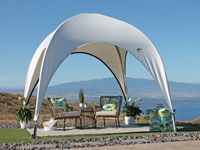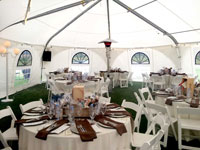For many years, the United States has held the highest incarceration rate in the world, with over 2.1 million prisoners in the system as of 2021. That’s about 25% of the world’s total number of people behind bars.
With jails and prisons often near capacity, overcrowding is a real issue that jeopardizes the safety, sanity, and sanitary needs of inmates. And while incarceration rates dropped for about a year during the pandemic, rates are gradually ticking back up and likely to be higher in the future.
With rising rates, it’s important that inmates have a safe and clean environment that’s conducive to their rehabilitation for future release. Positive environments promote proactive behavior, so properly sustained facilities should be a priority.
However, quality buildings at correctional facilities are often sparse. They’re much more expensive and complicated to build compared to standard urban buildings that don’t require security measures.
Depending on security requirements, Alaska Structures® offers high-quality engineered fabric shelters that serve as viable alternatives for your correctional facility construction needs.
Building Needs at Correctional Facilities
The Federal Bureau of Prisons (BoP) uses a ranking system to determine the amount of security needed at an institution, such as little to no perimeter fencing, number of prisoners per employee, watch towers, external patrols, and more.
The security ranking system is either minimum, low, medium, high, complex, or administrative. Complex means that correctional facilities in close proximity to each other require different security levels. This makes building options limited alongside challenging obstacles faced by correctional facility construction teams.
For example, minimum-security institutions, better known as federal prison camps (FPCs), are typically work- and program-oriented with dormitory housing on-site. Many minimum-security correctional facilities have camps next to their main facility — known as Satellite Prison Camps (SPCs) — that are used for labor that benefits either the main facility or off-site work programs.
Since SPCs require little security, building options are more flexible than high- or maximum-security prison institutions. However, some correctional facilities with low to medium security could also benefit from fabric building alternatives used for housing and sleeping quarters, dining, workshop and maintenance space, offices, and more.
[Related: Rethinking Dining Facilities — Superior Solutions With Fabric Structures]
Construction Challenges at Correctional Facilities
Correctional facility construction often faces a plethora of challenges since institutions are hosting hundreds to thousands of inmates in remote locations. Traditional construction plans bring issues to the forefront, causing the federal prison system to hold back when acquiring much needed facilities or even making improvements to current ones.
Funds
Finances are often a challenge that arise with correctional facility construction. Traditionally built structures are often expensive and time-consuming to construct, which causes authority figures and decision-makers to struggle when seeking funding from either the government or surrounding community.
Environment
The terrain and general environment are common challenges during correctional facility construction; buildings need to be able to withstand the region’s climate and weather patterns without putting the facility and inmates at risk. Having the proper amount of space and location is also a factor — once a conventional building’s construction is complete, there’s no changing where or how it’s positioned, which can lead to future challenges when institution property plans change.
Design
Design is an important factor as well. Many assume correctional facility construction projects result in gray and dreary layouts, but more institutions are becoming open to designs that create a sense of inspiration and purpose for inmates while they work toward rehabilitation.
Crews and Supervisors
Hiring construction personnel as well as site supervisors is an additional cost to an institution’s budget for correctional facility construction. There’s also a risk of workers being inside or on property grounds around inmates for prolonged periods of time. This puts stress on security officers who might already be overworked to begin with, while also disrupting institutional operations.
Fabric Building Solutions for Correctional Facilities
Benefits of Engineered Fabric Buildings for Correctional Facilities
Alaska Structures’ engineered fabric buildings are high-quality, well-designed structures that are rapidly deployable by nature. Since correctional facilities’ mandates and routines are often subject to change, our fabric buildings can be brought on- or off-site or relocated to a different area of the property in a short amount of time at all while ensuring building code and other design requirements are met.
They’re also extremely durable thanks to our high-strength frame systems — available in galvanized steel or aircraft-grade aluminum with optional powder coating for superior durability — and tensioned fabric membranes that feature UV stabilizers to resist high solar loads, abrasion, mildew and mold, and more for a long-lasting life.
Alaska Structures’ fabric building solutions can withstand severe climates and weather, too, including heavy snow loads, hurricane-force winds, and extreme temperatures.
Our fabric structures require minimal foundations and can be anchored on virtually any level surface, including dirt, gravel, sand, and concrete. What’s more, Alaska Structures’ fabric buildings don’t require construction crews since minimal skill is required for their assembly and installation.
Many customization options are available for all of our fabric structures to accommodate your correctional facility construction needs. HVAC and plug-and-play lighting and electrical systems are optional add-ons to facilitate proper lighting and internal temperature regulation for inmates and staff. Windows and skylights are available for brighter working and living conditions, and if more space for inmates is needed, our structures feature expansion capabilities.
[Related: The Benefits of Fabric Buildings From Alaska Structures]
Types of Fabric Buildings for Correctional Facilities
Alaska Structures’ remote camp systems can provide correctional institutions with a variety of on-site facilities, ranging from housing to workshops or storage and warehouse solutions.
Our modular housing for workforce accommodations is a great option to consider for inmate dormitories since they’re large, measuring 24 feet wide and configurable to multiple lengths, leaving ample room for current and incoming inmates as well as modular offices for staff and security personnel.
The DAGB Series is a double-truss gable building system capable of meeting any large building requirements, such as:
- Kitchen and dining halls
- Garages and maintenance facilities
- Administrative offices for correctional facility staff
- Worship facilities
- Gymnasiums and athletic facilities to accommodate the health and well-being of inmates
[Related: Engineered Fabric Building Applications: How to Use Fabric Buildings]
Fabric Buildings Provide Construction Solutions for Correctional Facilities
To learn more about Alaska Structures or how to acquire engineered fabric buildings for your correctional facility, email us, or request a quote by completing our online inquiry form.
Featured image via Pixabay

















































































Leave a Reply